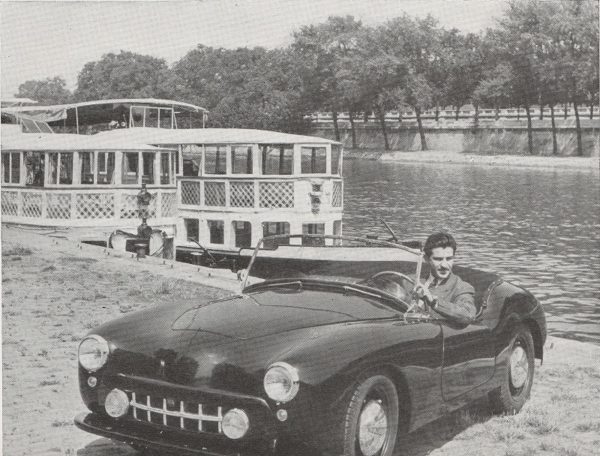
This pretty but slightly awkward little roadster sitting beside the Seine in Paris hides a more distinguished story. It is a Callista Ranelagh. Although no more than ten examples were ever made, one example ran at the Le Mans 24-hour race in 1951, driven by Jean-Paul Colas and Robert Schollmann. It finished – but 27th out of 30 entrants.
The Callista company was founded in Paris in the late 1940s by Antonio Monge and Robert Rowe. Its original project was a little convertible sports car based on Dyna Panhard mechanical components, named the “Coupe des Alpes”, seen in prototype form at the 1950 Paris Salon. The Dyna Panhard’s front-wheel-drive layout and flat-twin 750 cc engine mounted ahead of the front wheel centres dictated the look of the Callista’s significant front overhang.
A significant investor in the business was Raymond Gaillard, a regular competitor in the Le Mans 24-Hour race and the owner of a Parisian Panhard dealership, who was hoping to be sales distributor for the car. Once production started, the company offered two models: the “Coupe des Alpes” convertible and the shorter-wheelbase roadster, the Ranelagh. Its name derived from the location of Gaillard’s dealership in the fashionable Rue du Ranelagh in Paris. The convertible was 4,100 mm in length and weighed 550 kg, and the even shorter roadster that we see here was 3,620 mm in length and weighed a mere 550 kg. With this lack of weight an unsurprising top speed of 135 km/h (84 mph) was claimed.
Sadly these low-volume cars, however elegant, were severely undercut in price by the Dyna Junior launched by Panhard at the same 1950 show as the prototype, and the company had failed by the end of 1952. The two founders fell out, and Monge decided to return to preparing cars for motor sport events. Shortly after, worse was to come. Rowe was financially ruined after importing to France several hundred Romanian tractors that proved to be defective. This left the Callista project dead in the water.
But Gaillard was determined to rescue the remains of the business. He revived the company, now under the name of Arista, and reintroduced the Ranelagh roadster, renaming it for obvious reasons the Arista Le Mans. It is thought that around 100 Arista roadsters were built.
A fibreglass-bodied coupé arrived in 1956, known as the Arista Passy and powered by the 42 CV 848 cc engine from the Panhard PL17. It was still listed in 1962. A model with the 50 CV Panhard “Tigre” engine was sold as the Arista Sport, although the weight savings over a regular Panhard PL17 with that same higher-performance engine was only about 80 kg because of the Arista’s generous equipment. This little coupé was stylish but by now extremely expensive for its performance and the Arista name disappeared by 1963.
Picture courtesy of the Richard Roberts Archive







Leave a Comment